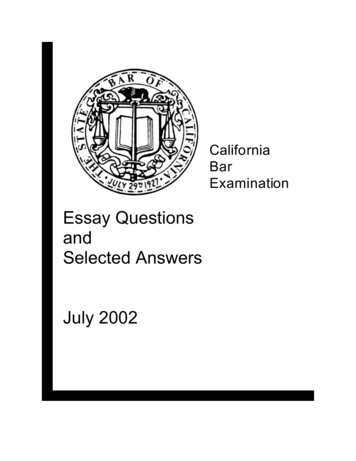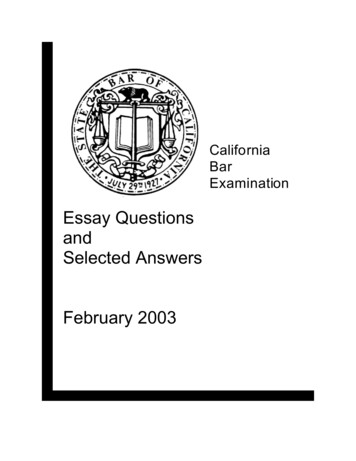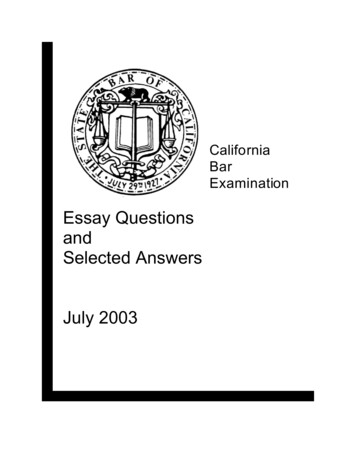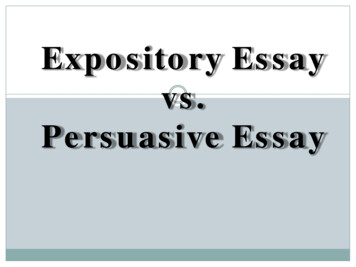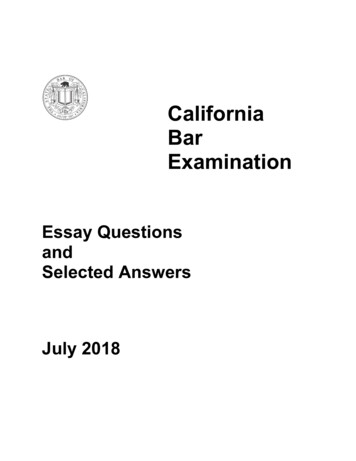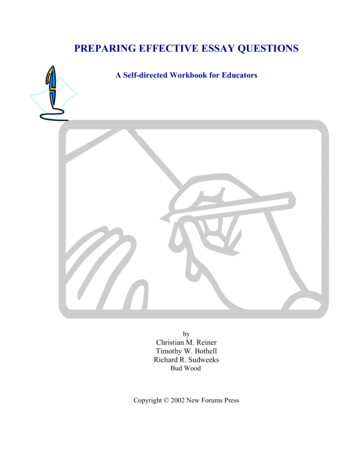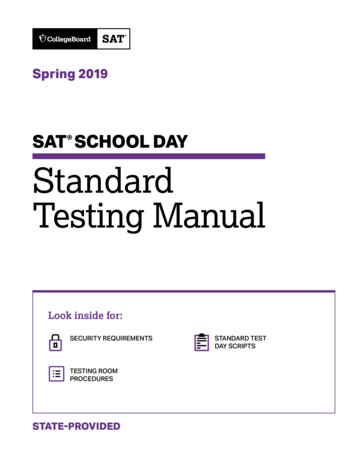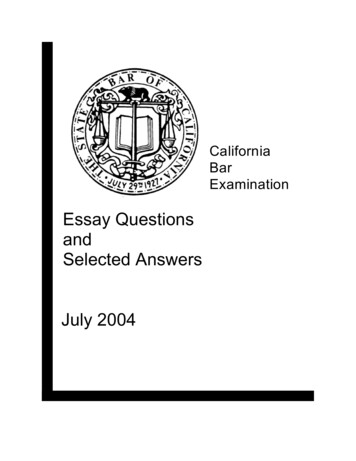
Transcription
CaliforniaBarExaminationEssay QuestionsandSelected AnswersJuly 2004
ESSAY QUESTION AND SELECTED ANSWERSJULY 2004 CALIFORNIA BAR EXAMINATIONThis publication contains the six essay questions from July 2004 California Bar Examinationand two selected answers to each question.The answers received good grades and were written by applicants who passed theexamination. The answers were prepared by their authors, and were transcribed assubmitted, except that minor corrections in spelling and punctuation were made for easein reading. The answers are reproduced here with the consent of their authors.Question NumberContentsPage1.Criminal Law12.Constitutional Law123.Wills/Trusts224.Evidence335.Professional Responsibility446.Tarts51i
TUESDAY MORNINGJULY 27, 2004CaliforniaBarExaminationAnswer all three questions.Time allotted: three hoursYour answer should demonstrate your abilityto analyze the facts in question, to tell thedifference between material and immaterialfacts, and to discern the points of law and factupon which the case turns. Your answershould show that you know and understandthe pertinent principles and theories of law,their qualifications and limitations, and theirrelationships to each other.Your answer should evidence your abilityto apply law to the given facts and to reason ina logical, lawyer-like manner from thepremises you adopt to a sound conclusion.Do not merely show that you rememberlegalprinciples. Instead, try to demonstrate yourproficiency in using and applying them.If your answer contains only a statement ofyour conclusions, you will receive little credit.State fully the reasons that support yourconclusions, and discuss all points thoroughly.Your answer should be complete, but youshould not volunteer information or discusslegal doctrines which are not pertinent to thesolution of the problem.Unless a question expressly asks you to useCalifornia law, you should answer accordingto legal theories and principles of generalapplication.
Question 1On August 1, 2002, Dan, Art, and Bert entered Vince’s Convenience Store. Dan and Artpointed guns at Vince as Bert removed 750 from the cash register. As Dan, Art, and Bertwere running toward Bert’s car, Vince came out of the store with a gun, called to them tostop, and when they did not do so, fired one shot at them. The shot hit and killed Art. Danand Bert got into Bert’s car and fled.Dan and Bert drove to Chuck’s house where they decided to divide the 750. When Chucksaid he would tell the police about the robbery if they did not give him part of the money,Bert gave him 150. Dan asked Bert for 300 of the remaining 600, but Bert claimed he,Bert, should get 500 because his car had been used in the robbery. Dan became enragedand shot and killed Bert. He then decided to take all of the remaining 600 for himself andremoved the money from Bert’s pocket.On August 2, 2002, Dan was arrested, formally charged with murder and robbery,arraigned, and denied bail. Subsequently, the court denied Dan’s request that trial be setfor October 15, 2002, and scheduled the trial to begin on January 5, 2003. On January 3,2003, the court granted, over Dan’s objection, the prosecutor’s request to continue the trialto September 1, 2003, because the prosecutor had scheduled a vacation cruise, astatewide meeting of prosecuting attorneys, and several legal education courses. OnSeptember 2, 2003, Dan moved to dismiss the charges for violation of his right to a speedytrial under the United States Constitution.1. May Dan properly be convicted of either first degree or second degree murder, and, ifso, on what theory or theories, for:a. The death of Art? Discuss.b. The death of Bert? Discuss.2. May Chuck properly be convicted of any crimes, and, if so, of what crime or crimes?Discuss.3. How should the court rule on Dan’s motion to dismiss? Discuss.
Answer A to Question 11)1. A. Dan - Liability for Art’s DeathMurderMurder is the unlawful killing of a human being with malice aforethought. Malice can beshown by either intent to kill, intent to cause grevious bodily harm, or reckless indifferenceto human life. Here, Dan is probably not liable under any of these theories. BecauseVince, the shopkeeper, shot Art, causing his death, Dan did not exhibit intent to kill orcause grevious bodily harm. Likewise, fleeing probably does not constitute recklessindifference to human life.Felony Murder RuleHowever, Dan might be convicted under the felony murder rule. The felony murder ruleholds defendants liable for foreseeable killings committed during the commission ofinherently dangerous felonies. Here, Dan, Art, and Bert were engaged in a robbery. Arobbery is the taking and carrying away of the personal property of another by force withthe intent to permanently deprive the victim of the property. Dan, Art and Bert robbedVince because they took 750 from him at gunpoint, with the intent to keep the money.A robbery - especially an armed robbery of a convenience store - is likely an inherentlydangerous felony. Art’s death was the kind of death that frequently results from armedrobberies, and thus was foreseeable.Limitation of Felony Murder Rule - FleeingLiability for felony murder generally ends when the felons reach a place of safety after thefelony. Here, because Art was killed while fleeing - before the felons reached a place ofsafety - this limitation will not apply.Limitation on Felony Murder Rule - Death of a Co-FelonHowever, most states have enacted limitations on the felony murder rule when the deathof a co-felon is at issue. Under states that follow the agency rationale, a defendant can befound guilty if the killing was done by a felon or his agent. Under this view, Dan is likely notliable for felony murder because it was Vince rather than Dan or Bert who shot Art.Under the proximate cause view of the felony murder rule, any killing proximately causedby the felony can make a defendant liable for felony murder. Under this rule, it is arguablethat Dan should be liable for Art’s death. Being shot while fleeing from a conveniencestore robbery is foreseeable. Thus, if the jurisdiction follows this view, Dan might be liable2
for Art’s death under a felony murder theory.First Degree MurderIn most states, first degree murder requires premeditation or deliberation. Many statesalso include murders that fall under the felony murder rule in the definition of first degreemurder. Thus, if this jurisdiction adheres to that view, Dan may be liable for first degreemurder for Art’s death.Second Degree MurderSecond degree murder generally is murder that does not involve premeditation anddeliberation, but also does not amount to any form of manslaughter. If the applicablestatute defines felony murder as second degree murder, Dan may be liable for that crimeinstead.ConspiracyConspiracy requires an agreement to commit a crime between two or more people, anintent to agree, an intent to commit a crime, and an overt act. A conspirator is liable for allreasonably foreseeable crimes committed in furtherance of the conspiracy. Here, Art, Dan,and Bert clearly agreed to rob Vince’s store with the intent to commit the crime.Conspiracy does not merge with the completed crime. Thus, if Dan was liable forconspiracy, and a court found that Art’s death was foreseeable, Dan could potentially beliable on these grounds as well. However, this is a stretch, especially since Vince killed Art.B. Dan’s Liability for the Death of BertMurderAs mentioned, one potential grounds of liability for murder is intentional killing or killing withan intent to cause great bodily harm. Here, Dan probably intended to kill Bert or at leastintended to cause him great bodily harm. Dan simply shot Bert - there is no indication thathe was merely trying to scare him.First Degree MurderDan may be liable for first degree murder. Although premeditation and deliberation aregenerally prerequisites to a charge of first degree murder, some courts have held that onecan premeditate or deliberate in very short periods of time. However, Dan will argue thathe was “enraged” and had no time to deliberate or premeditate. Due to the spontaneousnature of the crime, Dan will likely not be found guilty of first degree murder. In addition,as discussed below, he is likely not guilty of felony murder. Thus, even if the state murderstatute includes felony murder as first degree murder, Dan will likely not be liable for this3
crime.Second Degree MurderDan is much more likely to be guilty of second degree murder. As discussed above, heintended to kill Bert, but likely did not premeditate or deliberate. As discussed below, heis unlikely to be guilty of voluntary manslaughter or felony murder.Felony MurderA felony murder charge against Dan would be problematic. For one, liability for felonymurder generally ends when the perpetrators have reached a place of safety. Dan andBert had reached Chuck’s house when Dan killed Bert. Indeed, they had begun to divideup the money. This would likely cut off any liability for felony murder based on the robberyof Vince’s store.In addition, the prosecution might argue that Dan is liable for felony murder because hetook 600 from Bert’s pocket. The prosecution might argue that this is a robbery, and thatDan’s killing was a foreseeable result of the robbery. However, this is a weak argument.Dan only decided to take the money from Bert after he shot him. In addition, Dan mightalso be able to argue that since Bert did not have lawful title to the money, no robbery tookplace. This is because one element of a robbery is that the money be “property ofanother.” Thus, Dan is likely not liable for felony murder for Bert’s death.Voluntary ManslaughterDan may argue that he is only liable for voluntary manslaughter. Voluntary manslaughteris a killing that would be murder, but was conducted while the perpetrator was highly upset.The upsetting incident must be the sort that would upset a reasonable person, thedefendant must have been upset, a reasonable person would not have had time to cooloff, and the defendant must not have cooled off. Dan will argue that he was “enraged” byBert’s demand of extra money. However, this argument is unlikely to succeed. For one,Bert’s actions do not rise to the type of extremely upsetting provocation that generallysuffices to reduce a murder charge to voluntary manslaughter. Moreover, there is noindication that a reasonable person would have had such a violent reaction to Bert’sdemand for money. Thus, Dan is likely not liable for voluntary manslaughter.ConspiracyAs discussed above, any underlying conspiracy to rob Vince’s store had likely ended bythe time that the robbers reached Chuck’s house.2.Chuck’s Liability4
Accessory After the FactChuck is likely guilty of being an accessory after the fact. An accessory after the fact isone who shields, shelters, or assists criminals after a crime. Chuck is clearly aware thatDan and Bert have committed a robbery. He threatens to tell the police about the crimeunless he receives some of the money. He provides his house as a safe haven for Danand Bert. If found guilty of this charge, Chuck would not be guilty as an accomplice - hewould simply be guilty of an independent, lesser offense.AccompliceChuck is probably not an accomplice to either Dan’s killing of Bert or the robbery of Vince.To be an accomplice, one must assist a crime with the intent that the crime be committed.Here, there is no indication that Chuck had any idea that Dan, Art and Bert were going torob Vince’s store. In addition, given the spontaneous nature of Dan shooting Bert, thereis no indication that Chuck intended that crime either. Mere presence at a crime scenedoes not necessarily result in accomplice liability.ExtortionChuck perhaps is guilty of extortion. Extortion involves the obtaining of property throughthreats. Here, Chuck threatened to tell the police about the robbery. As a result, heobtained 150 from Dan and Bert. Thus, because he obtained property through the useof threats, he might be guilty of extortion.ConspiracyThere is no indication that Chuck was involved in any agreement - or even knew about the convenience store robbery. Also, Dan seems to have acted alone when he shot Bert.Accordingly, Chuck is likely not be [sic] guilty of conspiracy.Mispris[i]on of FelonyIf the jurisdiction recognizes this crime, Chuck may be guilty because he aided andassisted Dan and Bert to cover up their crime.3.Dan’s Motion to DismissThe Sixth Amendment to the United States Constitution protects an accused’s right to aspeedy trial. When evaluating whether such a right has been violated, courts considerseveral factors. Among them are the reason for the delay, whether the defendant hasobjected to the delay, and the length of the delay.5
Here, Dan’s strongest argument is that the prosecutor’s reasons for delaying the trial aresimply not compelling enough to warrant impinging upon his constitutional rights. Theprosecutor’s desire to go on vacation and attend meetings and legal education classesseems more like a personal pred[i]lection than a good reason to delay Dan’s trial. Dan willlanguish in jail during this time - nearly thirteen months after he was arrested andarraigned. Moreover, with the exception of the vacation, it is not at all clear why theprosecutor cannot attend the meeting or legal education courses on his own time. Finally,in any event, it is not clear why those events warrant delaying the trial from January 3 toSeptember 1 - a delay of nine months. Dan will also note that he initially moved to havetrial set in October, 2002. Finally, Dan will point out that the prosecutor’s motion wasgranted on Jan. 3, which was essentially the eve of trial. Waiting until the last minute tocontinue a trial so long seems unfair and may have prejudiced his ability to mount aneffective defense.However, the prosecution will counter that Dan should have moved to have his chargedismissed on Jan. 3. Indeed, Dan waited until September 2 to move to dismiss. Althoughhe “objected” on Jan. 3, he should have moved to dismiss then. By waiting to move todismiss until after the trial began, Dan likely waived his rights. Accordingly, Dan’s motionshould be denied.6
Answer B to Question 11)May Dan (“D”) be convicted of murder.The first question is whether Dan may be convicted of murder in the 1st or 2nd degree. Atcommon law, murder was the unlawful killing of a human being with malice aforethought.Malice aforethought was committing murder with any of the following mental states (1)intent to kill, (2) intent to do serious bodily harm, (3) reckless indifference to theunjustifiably high cost to human life and (4) intent to commit a felony. The types of feloniesincluded in felony murder were inherently dangerous felonies.Murder in the first degree is a statutory creation that involves the unlawful killing of anotherhuman being with premeditation and deliberation. In addition, many state statues havealso included in the definition of murder in the first degree murders committed whilecommitting a felony -- also enumerating inherently dangerous felonies.Voluntary manslaughter is the unlawful killing of a human being which would be murder butfor the existence of adequate provocation, and involuntary manslaughter is the killing ofanother human being with criminal negligence or during the commission of anunenumerated felony or misdemeanor.2d Degree murder is a residual murder category that covers the unlawful killing of anotherhuman being that does not fall within the Murder in the 1st Degree or Voluntary orInvoluntary Manslaughter categories. With this in mind, we can investigate whether Danis liable for murder in the first or second degree.All homicide crimes also require actual and proximate causation as well as the result ofdeath.KILLING OF ART.Here, Dan did kill Art. Vince killed Art. Thus, the only theory that could convict Dan of themurder of Art would be the felony murder. Here, Art and Dan and Bert were committingrobbery, an inherently dangerous felony.Robbery is the taking of personal property of another from their person or presence byforce or threats of force with the intent to permanently deprive.Here, Dan, Bert and Art entered the convenience story and pointed guns at Vince (therequisite threat of force) and took 750 (personal property) from Vince’s person. This,especially because of the existence of guns, qualifies as an inherently dangerous felonythat should rise to the level of a felony that would qualify for Felony murder. Thus,7
because the killing of Art took place whil[e] Dan was committing an inherently Dangerousfelony, if this occurred in a jurisdiction where felony murder is included in the definition offirst degree murder, Dan could be guilty of first degree murder.There are however some limiting doctrines to felony murder. Notably in this instance, thekilling must be a foreseeable result of the felonious conduct, and the redline view of felonymurder provides that defendants cannot be guilty of felony murder for the murder of oneof their co-felons by the police or by third parties. Thus, although the killing of Art certainlyis a foreseeable result of committing a robbery, if this is a jurisdiction that follows theredline view, Dan will not be guilty of felony murder for Art, and will not be guilty of eitherfirst or second degree murder for Art.It is noteworthy that Vince’s killing of Art was not lawful because one may never use deadlyforce in defense of property, and here, Vince chased Art out of the store (after the physicaldanger to him passed) and killed Art, when Art failed to stop.FOR DEATH OF BERTThe next question is whether Dan can be guilty of murder in the first or second degree ofBert.The standards for murder in the first and second degree are set forth above. Here, thequestion will revolve around whether (1) Dan possessed the requisite premeditation anddeliberation to kill Bill, (2) whether Dan could be guilty of felony murder, since thishappened right after the robbery, or (3) whether adequate provocation existed to reducethe killing to a charge of involuntary manslaughter.Premeditation.Dan can be guilty of first degree murder of Bert if he committed the murder withpremeditation and deliberation. Here, the facts do not indicate that he possessed thatpremeditation. Dan and Bert just committed a robbery together and were returning todivide the money. There is nothing to suggest that he had a prior plan to kill Bert. In fact,he only became enraged when Bert insisted on taking the entire share for himself. Thus,on these facts, he cannot be convicted of first degree murder on a premeditation anddeliberation theory.Felony MurderThe next question is whether he could be convicted of felony murder for the murder of Bert.Dan did just commit a felony (robbery) as discussed above. He had the requisite intent tocommit that felony and it was an inherently dangerous felony. Thus, could his killing ofBert qualify for felony murder?8
The felony murder rule also has the limited doctrine that the killing must occur during thecommission of the felony. Once the felons reach a point of temporary safety, they are nolonger considered as carrying out the felony for purposes of the felony murder rule.Here, Dan and Bert had reached the safety of Chuck’s house and[,] therefore, were nolonger in the commission of a felony and[,] therefore, Dan cannot be guilty of felonymurder.2d Degree Murder and Voluntary ManslaughterThe next question is whether adequate provocation existed to make the killing a voluntarymanslaughter. If not, the murder will fall into the residual category of Murder in the 2ddegree. Here, since Dan acted with intent to do serious bodily damage to Bert (he shotand killed him), or at a minimum proceeded with reckless disregard for the unjustifiablyhigh risk to human life, he will be guilty of second degree murder if the charge isn’t reducedto voluntary manslaughter.Vol manslaughter requires (1) provocation aro[u]sing extreme and sudden passion in theordinary person such that he would not be able to control his actions, (2) the provocationdid in fact result in such passion and lack of control, (3) not enough time to cool off btwnthe provocation and the killin[g] [gna] d (4) the defendant did not in fact cool off.Here, Bert refused to give Dan his 300. While it is understandable that the failure to givesuch money would aro[u]se anger in an ordinary person that had just put their freedom andlife on the line in a robbery attempt, we are only talking about 300. While understandablyangry, it is hard to imagine that an average person would lose control over 300 to thepoint of taking another person’s life. Thus, Dan will not qualify for the reduction tovoluntary manslaughter and will be convicted of 2d degree murder.MAY CHUCK BE CONVICTED OF ANY CRIMESThe possible crimes Chuck could be convicted of is [sic] either all of the crimes that theprincipals committed (under an accomplice liability theory), or at a minimum an AccessoryAfter the Fact.ACCOMPLICE LIABILITYIf one aids, abets or facilitates the commission of a crime with the intent that the crime becommitted, one can be found guilty on accomplice liability theories. The scope of liabilityincludes liability for the crimes committed by the principals and all other foreseeablecrimes. The common law used to distinguish between principals in the first and seconddegrees and accessories before and after the fact. Largely those distinctions have beendiscarded, although, most jurisdictions still do recognize the lesser charge of accessoryafter the fact.9
Here, there is no evidence that Chuck aided, abetted or facilitated the crime until after itwas committed. He provided a safehouse and subsequently demanded money. But merepresence or knowledge is not enough to ground accomplice liability.ACCESSORY AFTER THE FACTHowever, Chuck did assist after the crime happened (he provided a safehouse, and agreednot to tell the authorities in exchange for money), so at a minimum he will be guilty ofaccessory after the fact.ExtortionChuck may also be liable for extortion. Extortion is the illegally obtaining property throughthreats of force or threats to expose information. Here, he threatened to expose thecriminals to the police if he didn’t get paid, and so he will be liable.Receiving Stolen PropertyChuck also will be liable for receiving stolen property. The requirement for this crime are[sic] that you know the circumstances around the property (ie, that it is stolen) and that youwilling [sic] receive it. Chuck knew this money was the fruit of a robbery and received it inexchange for his providing a safehouse. Thus he will be liable of receipt of stolen property.CONSPIRACYChuck also could be guilty of conspiracy. Conspiracy is (1) an agreement between two ormore people, (2) the intent to agree, (3) the intent to pursue an unlawful objective and (4)in some jurisdictions, some overt act. Conspiracy does not merge into the completedcrime.HOW SHOULD COURT RULE ON DAN’S MOTION TO DISMISS.The 6th amendment provides each defendant the right to a speedy trial. The 6th amd isapplied to the states through its incorporation into the due process clause of the 14thamendment. The right to a speedy trial attaches post charge. Whether the defendant hasbeen given a speedy trial depends on an analysis of the totality of the circumstances.Here, Dan was arrested on August 2, and immediately charged. Thus his right to a speedytrial attached sometime in early August. The initial trial date was set for January 5, 2003.It is not likely that the denial of Dan’s request for a trial 2 months after his charge is aviolation of his constitutional rights since the court set a date very closely thereafter inJanuary. However, the prosecutor’s delay subsequent to that date does not rise to thelevel of providing adequate excuse for moving Dan’s date (coupled with the fact that therequest was made only days before the January trial was to commence). Here, the10
prosecutor wanted to take a vacation cruise and take some legal education classes, andmeet for a statewide meeting of prosecutors. First, none of these seem to rise to the levelof an adequate excuse to delay a trial 9 months. Particularly since the defendant wasdenied bail and was sitting in jail. While the court could have granted a continuance for ashort period of time for the meeting or to accommodate the prosecutor, given thedefendant’s status (sitting in jail), it was improper for the court to grant this motion, and thecourt may dismiss Dan’s case.It should be noted, however, that Dan should have moved earlier than September 2, as thiswould have permitted the court to fashion relief without having to dismiss the chargealtogether. Accordingly, a court could find that he was not entitled to dismissal becauseof his delay.11
Question 2State X amended its anti-loitering statute by adding a new section 4, which reads asfollows:A person is guilty of loitering when the person loiters, remains, orwanders about in a public place, or on that part of private property thatis open to the public, for the purpose of begging.Alice, Bob, and Mac were separately convicted in a State X court of violating section 4.Alice was convicted of loitering for the purpose of begging on a sidewalk located outsidethe City’s Public Center for the Performing Arts in violation of section 4.Bob was convicted of loitering for the purpose of begging on a waiting platform at a stopon City’s subway system in violation of section 4.Mac was convicted of loitering for the purpose of begging in the lobby of the privatelyowned Downtown Lawyers Building located in the business district of City in violation ofsection 4.Alice, Bob, and Mac have each appealed their convictions, and their appeals have beenconsolidated in the State X appellate court. It has been stipulated that Alice, Bob, and Macare indigent, that section 4 is not void for vagueness, and that the only issue on appealconcerns the validity of section 4 under the First Amendment to the United StatesConstitution.How should the appellate court decide the three appeals, and why? Discuss.12
Answer A to Question 22)STANDINGSince the question states that the only issue on appeal concerns the validity of section 4under the First Amendment, it is assumed that all standing requirements are met.STATE ACTIONThe constitutional provisions of the first amendment are only applicable to state actionwhich deprives a citizen of his/her right to free speech. Here, State X passed a loiteringlaw affecting speech (expression), and later enforced that law by their police. Thereforethere is state action and Alice, Bob and Mac can allege their first amendment rights.SPEECHThe first amendment is raised with respect to a citizen’s rights for free speech or religion.Here, State X passed a law concerning loitering. This law concerns the right to freespeech, however, because speech is not limited to words spoken or written, but can alsoapply to free expression or demonstrative speech. Since this law affects where a personcan legally go (in public space) and what they can do in that public space, it does affectspeech.CONTENT-BASEDSpeech regulations can be either content-based or content-neutral. Content neutralregulations on speech are viewed more favorably than content-based regulations, becausethere is no discriminatory purpose on the face of the regulation. Here, however, theregulation affecting Alice, Bob and Mac concerns only those on the property “for thepurpose of begging.” Since the statute concerns only those who have particular purpose,a particular message (i.e. “please give me money if you can spare it”), the statute iscontent-based and will have to survive stricter scrutiny.OVERBREADTHWhile the statute is not void for vagueness, it could be challenged by all three for beingover broad. That is, it may not be narrowly tailored to serve the interest they are seekingto regulate. The statue seems aimed at prohibiting begging. However, it does not merelyprohibit begging but “remain[ing] or wander[ing] about in a public place for the purpose ofbegging.” This statute is arguably overbroad. Here, an officer can arrest someone, not forcommitting the actual act of begging, but for having that purpose. How can an officer, orjudge, or a jury possibly know whether a person has the purpose of begging? This statute13
invites abuse of indigent or undesirable people. Furthermore, the statute regulates“remaining” or “wandering about” in a public place. Again, this is overboard because itpunishes not only the act of begging but the right of a person to remain in a public placeor wander about there. Under this statute, an indigent could arguably be arrested fortaking a walk on the sidewalk or sitting in a public park -- if the officer believes that he hasthe “purpose of begging.”INDIGENCEIt is unconstitutional to pass a statute that places an unreasonable burden on indigentswith the respect to compliance (for example, unreasonable fines). Here, the statute &question do not say anything about fines or fees, so it is presumed that there is no unduefinancial burden on indigent people.Alice should win her AppealSIDEWALK PUBLIC FORUMAlice should win her appeal because she was “loitering.for the purpose of begging” on thesidewalk outside the Public Center for the Performing Arts. First, a sidewalk is generallya public forum. In a public forum, a person is given greater leeway to exercise their rightsof free speech. The city would have to have a strong justification for repressing Alice’sright of self-expression on a sidewalk, such as public safety.NO DANGER TO THE COMMUNITYWhile Alice might not be able to loiter on the sidewalk begging in front of a Fire Station (forexample) for public safety reasons, she should be able to do so in front of the publiccenter. There is no indication that there is any danger to the community in letting herexercise he
This public ation contains the six essay questi ons from July 2004 California Bar Examinat ion and two selected answers to each question. The answers received good grades and were written by applicants who passed the examination. The answers were prepared by their authors, and were transcribed as
